The Pachycephalosaurus (pronounced /paki.sɛfalo.saʊɾus/) is a genus marked by its distinctive dome-headed dinosaurs. It represents a unique branch of the ornithischian dinosaurs that lived during the Late Cretaceous period. Native to what is now North America, the Pachycephalosaurus was one of the last non-avian dinosaurs, living alongside giants like Tyrannosaurus rex and Triceratops before the mass extinction event.
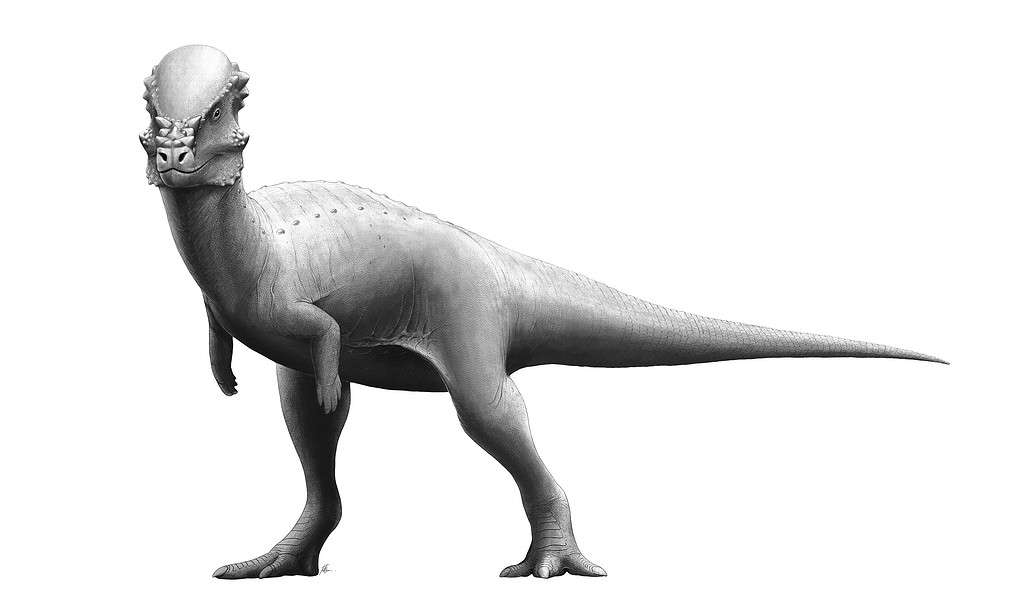
Discovery and Naming
The story of Pachycephalosaurus began in the 1850s. Early fossil collectors stumbled upon what would become known as Pachycephalosaurus fossils in Western North America. Ferdinand Vandeveer Hayden, one of these collectors, found a notable bone fragment in the late 1850s near the Missouri River. It wasn’t until Joseph Leidy‘s assessment in 1872 that the specimen was described, albeit inaccurately, as an armadillo-like creature known as Tylosteus. The true nature of this specimen remained obscured until a reevaluation by Donald Baird more than a century later, which identified it as a piece of Pachycephalosaurus skull, thus redirecting the trajectory of its classification.
The genus Pachycephalosaurus was formally introduced in 1943. Barnum Brown and Erich Maren Schlaikjer identified and named two species based on more complete skull material. This was a pivotal moment for this distinct genus, with Pachycephalosaurus wyomingensis later recognized as the type species. The dinosaur name translates to “Thick-Headed Lizard” and it is rather self-explanatory.
Physical Description
Pachycephalosaurus is an ornithischian dinosaur with a unique overall morphology. The centerpiece is an exceptionally thick skull roof, up to 22 centimeters thick. This dome-shaped structure evolved possibly for head-to-head combat or display. But despite their intimidating appearance, these spikes were more likely for display rather than defense. The skull’s rear sported bony knobs and short spikes projected upwards from the snout. Their blunted ends suggest a non-lethal function.
Pachycephalosaurus‘ forward-facing, large, rounded eye sockets suggest a predator-aware creature with potentially good depth perception. The dinosaur’s teeth were small, with leaf-shaped crowns adapted for a diet comprised of plants. However, the exact nature of this animal’s diet remains subject to further research.
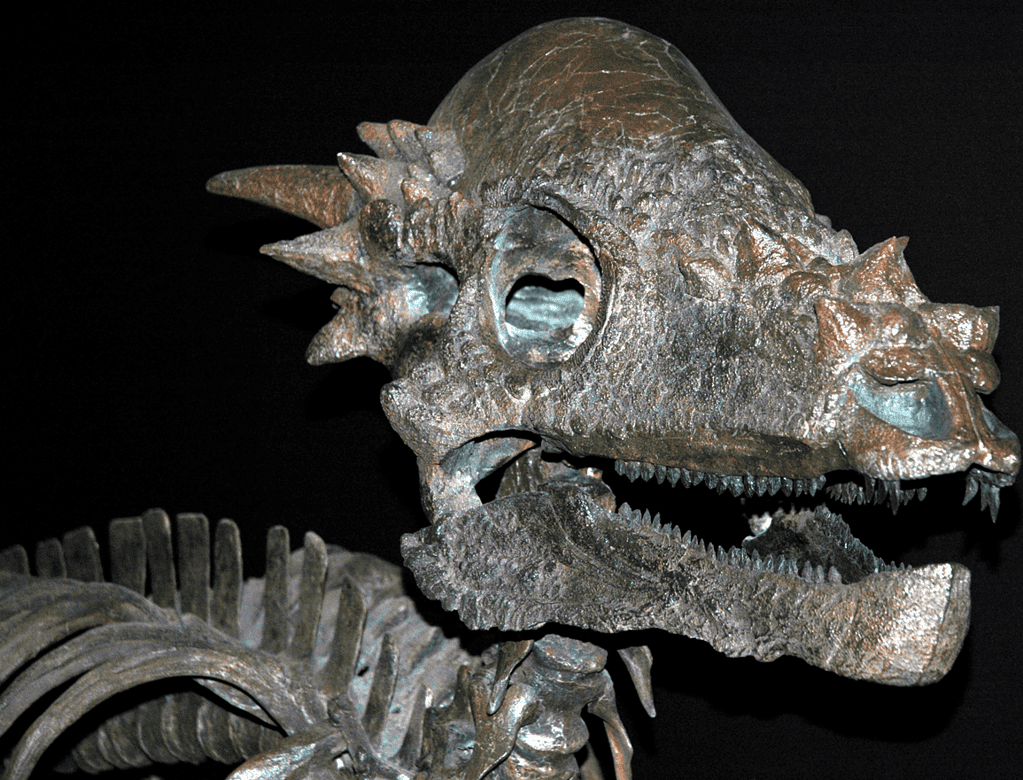
The overall anatomy of Pachycephalosaurus was well suited for bipedal locomotion. Its long, strong legs were designed for rapid movement, and its relatively small arms were equipped with five-fingered hands. This configuration enabled it to forage and potentially evade predators through swift movement. Pachycephalosaurus‘ body estimates suggest a length of approximately 4.5 meters and a weight ranging from 370 to 450 kilograms.
Diet and Behavior
The dietary habits of Pachycephalosaurus, while not directly observable, can be inferred from its dentition and jaw structure. Pachycephalosaurus had small, leaf-shaped teeth, making it an obvious herbivor. The teeth were suited for processing a mixed diet that may have included leaves, seeds, and possibly fruit. Serrated edges on some teeth indicate an ability to shred plant material. This evidence points towards a diet that could vary in texture and toughness.
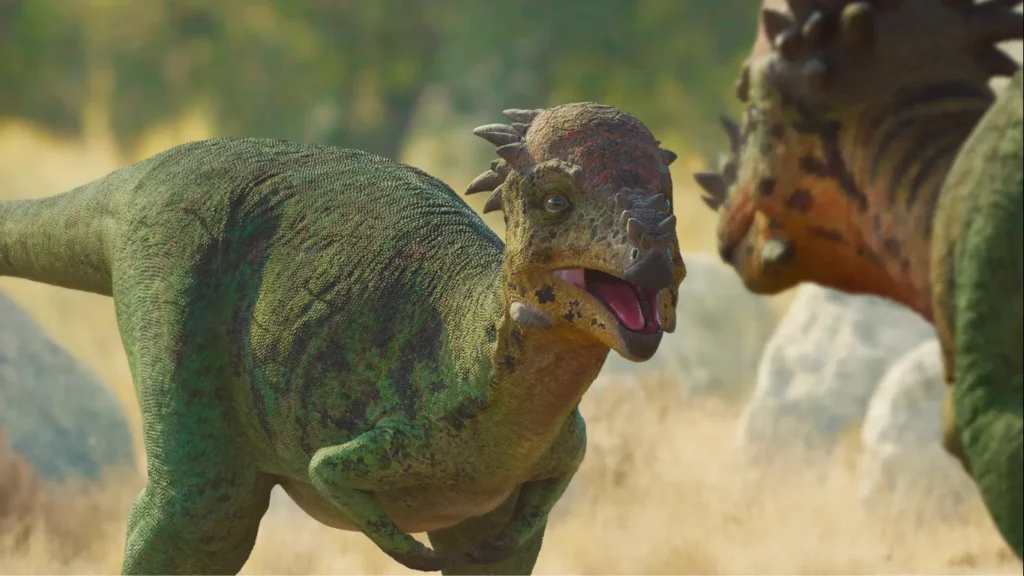
Behaviorally, Pachycephalosaurus presents a fascinating subject for paleontologists. The genus’ thick, domed skull, has led to various interpretations regarding its use. One prevalent hypothesis suggests that similar to modern-day bighorn sheep or muskoxen, Pachycephalosaurus might have engaged in intraspecific combat. The domed head would have served as a battering ram during contests for territory or mating rights.
This behavior hints towards a complex social structure where physical displays played a significant role in hierarchy and mating success. However, this interpretation has been met with skepticism due to the potential risk of injury such behavior could pose to the brain. Alternative theories propose that the dome and surrounding spikes were used more for display rather than direct combat. Moreover, the biomechanics of the skull and neck might not have supported the stresses associated with head-to-head impacts.
More recently, a 2023 study analyzed a well-preserved Pachycephalosaurus skeleton and created a 3D model. The researchers compared the dinosaur’s anatomy, particularly the tail and leg muscles, to that of modern kickboxing animals like kangaroos. They found striking similarities, suggesting Pachycephalosaurus may have used its powerful legs and tail for kicking instead of head-butting.
Growth and Development
Pachycephalosaurus underwent rather dynamic changes throughout its lifespan. Paleontologists think juveniles had flatter skulls with pronounced horns projecting from the rear. As they aged, these dinosaurs underwent a dramatic transformation. The dome grew larger as they reached adulthood while the horns receded. Such ontogenetic changes imply varying behaviors associated with different life stages, potentially influencing interaction between individuals within social groups.
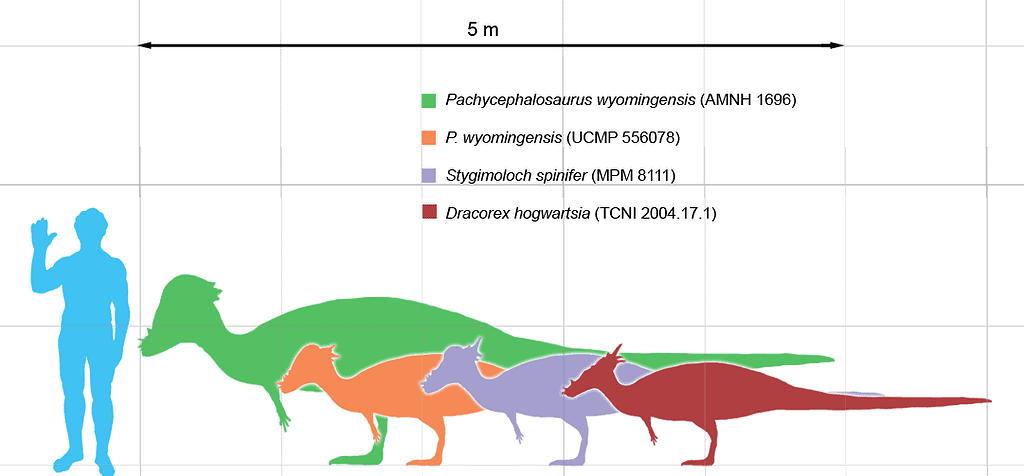
The debate regarding the purpose of the thickened skull dome in Pachycephalosaurus intersects with its growth patterns. Some scientists propose that the dome’s development was linked to reaching sexual maturity. A display feature to attract mates or establish dominance. This theory aligns with observations in modern animals where secondary sexual characteristics become more pronounced with maturity. Recent studies have suggested that what were once considered separate species based on skull shapes—such as Dracorex and Stygimoloch—might actually represent juvenile or subadult stages of Pachycephalosaurus.
Paleoecology
Pachycephalosaurus roamed Western North America during the Maastrichtian stage of the Late Cretaceous period. This era, just before the Cretaceous-Paleogene extinction event, showcased diverse ecosystems. The habitats varied from coastal plains to dense forests, supporting an array of plant and animal life.
The environment was rich in flowering plants, ferns, and conifers, providing ample food for herbivores. This lush vegetation not only sustained Pachycephalosaurus but also attracted a plethora of other herbivores, creating a dynamic ecosystem where plant-eaters and predators interacted.
Pachycephalosaurus shared its world with other dinosaurs like the mighty Tyrannosaurus rex, the armored Ankylosaurus, and the horned Triceratops. Water sources like rivers and lakes dotted the landscape, vital for the survival of these species. Fossils from Montana, South Dakota, Wyoming, and Alberta provide evidence of Pachycephalosaurus‘ presence across a vast region. These remains, mainly skulls and thick skull roofs, are crucial for understanding the animal’s role in the ecosystem.
The presence of other pachycephalosaurids, such as Sphaerotholus and Stygimoloch with Dracorex (potential juveniles), suggests that Pachycephalosaurus was part of a nuanced ecosystem where similar species occupied different niches. This diversity indicates a complex social and ecological interaction pattern among these dome-headed dinosaurs.
Pachycephalosaurus in Popular Culture
Pachycephalosaurus, with its distinctive dome-headed silhouette, has transcended the boundaries of paleontological research to become a staple in the popular imagination. Its distinctive appearance, particularly its domed skull, has made it a subject of fascination and speculation, leading to its portrayal in various media, from literature and film to video games.
Pachycephalosaurus is most famous for its appearance in the “Jurassic Park” franchise. These films showcase the dinosaur in dramatic scenes that emphasize its unique head-butting behavior. While scientists might debate the accuracy of these portrayals, it has become a dinosaur that filmgoers recognize and remember, alongside Tyrannosaurus rex and Velociraptor.
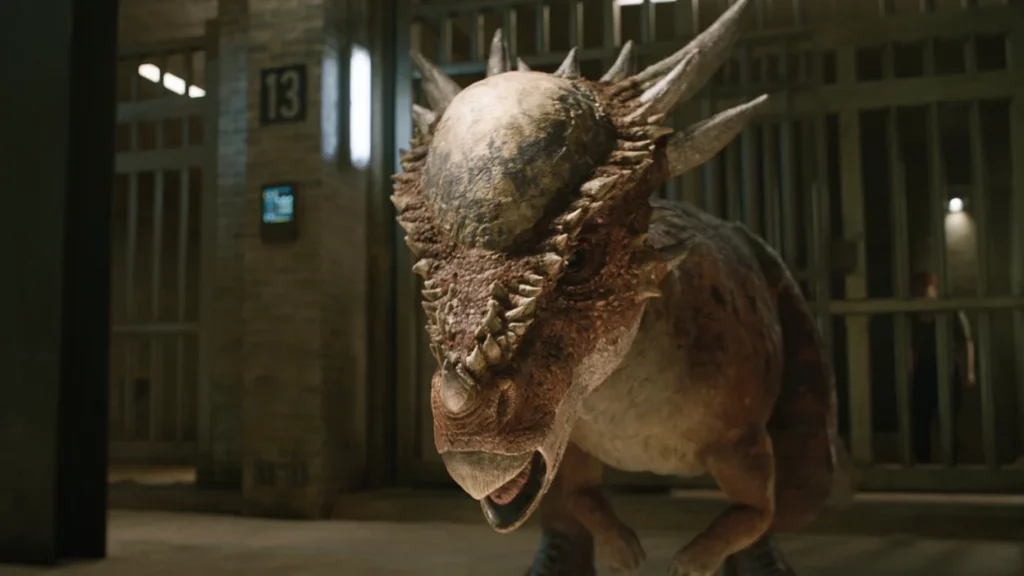
Pachycephalosaurus has made appearances in various documentaries and educational series that explore the fascinating world of dinosaurs. One specific episode that highlights Pachycephalosaurus is from the series “PaleoWorld”, Season 3, Episode 3, titled “Boneheads”. This episode delves into the unique characteristics and behaviors of Pachycephalosaurus, alongside other pachycephalosaurids like Homalocephale and Stygimoloch. Additionally, Pachycephalosaurus was featured in the highly acclaimed Apple+ series “Prehistoric Planet”. The series, renowned for its stunning visuals and scientific accuracy, presents a vivid reconstruction of the Late Cretaceous period, showcasing a wide array of dinosaurs and other prehistoric creatures, including Pachycephalosaurus.




